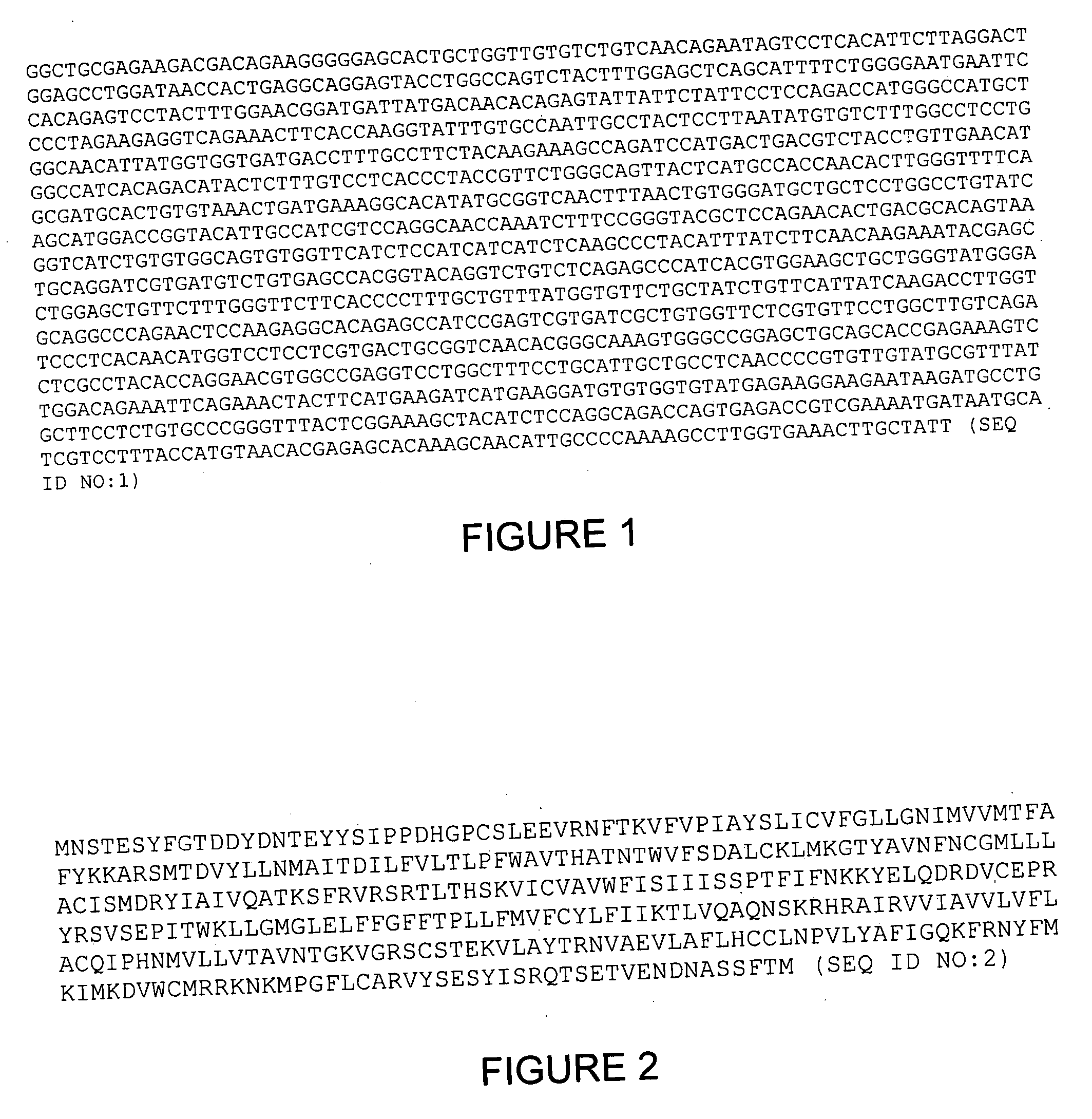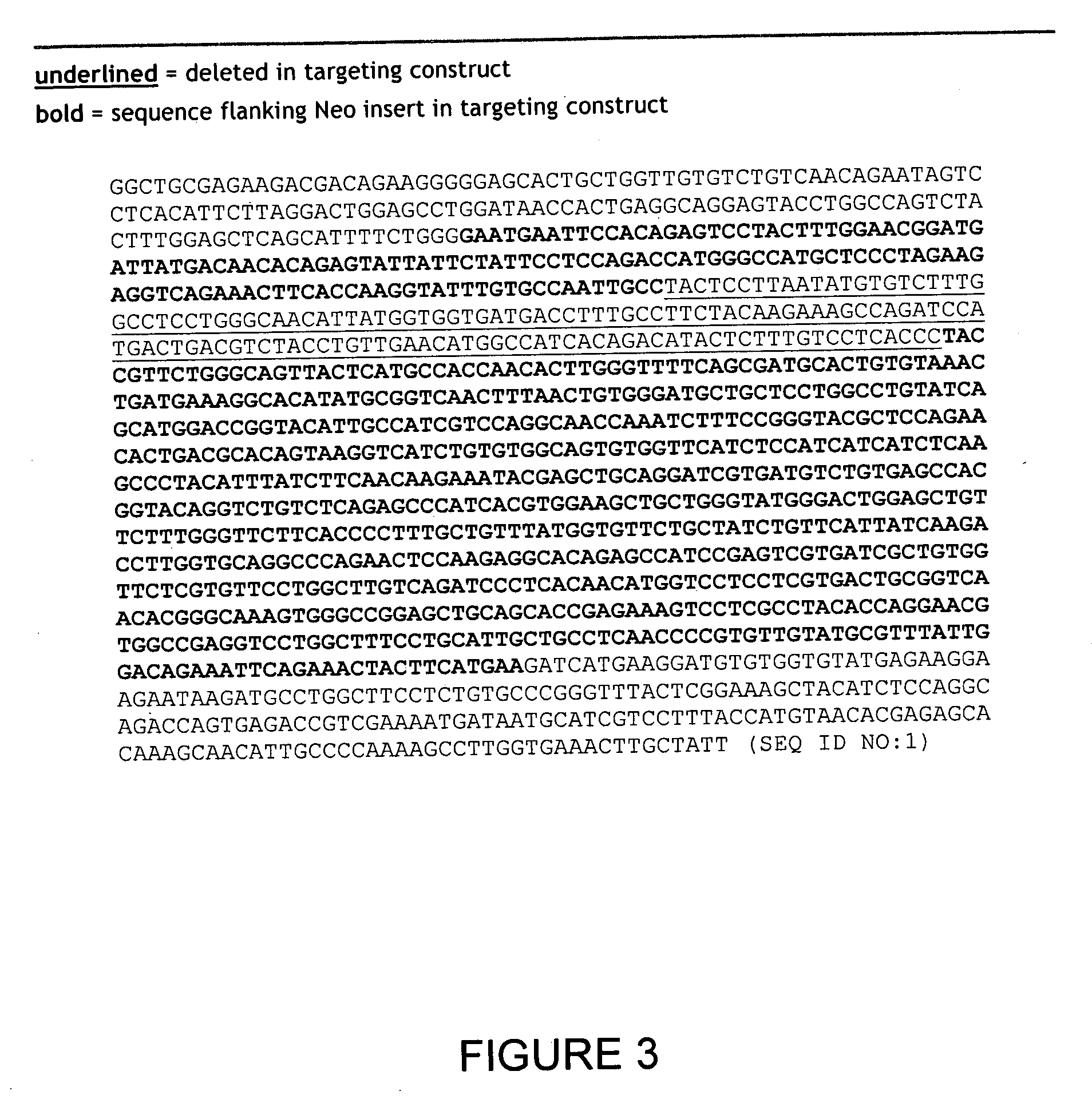CCR6 chemokine receptor disruptions, compositions and methods relating thereto
a chemokine receptor and ccr6 technology, applied in the field of transgenic animals, can solve the problems of the humoral immune response impaired by oral antigen administration in the mice, and achieve the effects of increasing body weight loss, reducing survival, and increasing disease severity
- Summary
- Abstract
- Description
- Claims
- Application Information
AI Technical Summary
Benefits of technology
Problems solved by technology
Method used
Image
Examples
example 1
Generation of Mice Comprising CCR6 Gene Disruptions
[0226] To investigate the role of CCR6, disruptions in CCR6 genes were produced by homologous recombination. Specifically, transgenic mice comprising disruptions in CCR6 genes were created. More particularly, as shown in FIG. 4, a CCR6-specific targeting construct based upon SEQ ID NO: 1 or the sequence identified in Genebank Accession No.: NM—009835; GI No.: 6753317, was created using as the targeting arms (homologous sequences) in the construct the oligonucleotide sequences identified herein as SEQ ID NO:3 or SEQ ID NO:4.
[0227] The targeting construct was introduced into ES cells derived from the 129 / OlaHsd mouse substrain to generate chimeric mice. The F1 mice were generated by breeding with C57BL / 6 females, and the resultant F1N0 heterozygotes were backcrossed to C57BL / 6 mice to generate F1N1 heterozygotes. The F2N1 homozygous mutant mice were produced by intercrossing F1N1 heterozygous males and females.
[0228] Genomic DNA fr...
example 2
Expression Analysis by RT-PCR
[0233] Total RNA was isolated from the organs or tissues from adult C57BL / 6 wild-type mice. RNA was DNaseI treated, and reverse transcribed using random primers. The resulting cDNA was checked for the absence of genomic contamination using primers specific to non-transcribed genomic mouse DNA. cDNAs were balanced for concentration using HPRT primers.
[0234] The highest levels of RNA transcripts were detectable in spleen and lymph nodes. Lower levels of RNA transcripts were detectable in lung, pancreas, thymus, bone marrow, skeletal muscle, stomach, small intestine, large intestine, cecum, testis, epididymis, seminal vesicle, coagulating gland and prostate gland.
[0235] No RNA transcripts were detectable in brain, cortex, subcortical region, cerebellum, brainstem, olfactory bulb, spinal cord, eye, Harderian glands, heart, liver, kidney, skin, gallbladder, urinary bladder, pituitary gland, adrenal gland, salivary gland, tongue, ovaries, uterus and white f...
example 3
Expression Analysis by LacZ Reporter Gene Analysis
[0236] Procedure: In general, tissues from 7-12 week old heterozygous mutant mice were analyzed for lacZ expression. Organs from heterozygous mutant mice were frozen, sectioned (10 μm), stained and analyzed for lacZ expression using X-Gal as a substrate for beta-galactosidase, followed by a Nuclear Fast Red counterstaining.
[0237] In addition, for brain, wholemount staining was performed. The dissected brain was cut longitudinally, fixed and stained using X-Gal as the substrate for beta-galactosidase. The reaction was stopped by washing the brain in PBS and then fixed in PBS-buffered formaldehyde.
[0238] Wild-type control tissues were also stained for lacZ expression to reveal any background or signals due to endogenous beta-galactosidase activity. The following tissues can show staining in the wild-type control sections and are therefore not suitable for X-gal staining: small and large intestines, stomach, vas deferens and epididym...
PUM
| Property | Measurement | Unit |
|---|---|---|
| temperatures | aaaaa | aaaaa |
| temperatures | aaaaa | aaaaa |
| temperatures | aaaaa | aaaaa |
Abstract
Description
Claims
Application Information
 Login to View More
Login to View More - R&D
- Intellectual Property
- Life Sciences
- Materials
- Tech Scout
- Unparalleled Data Quality
- Higher Quality Content
- 60% Fewer Hallucinations
Browse by: Latest US Patents, China's latest patents, Technical Efficacy Thesaurus, Application Domain, Technology Topic, Popular Technical Reports.
© 2025 PatSnap. All rights reserved.Legal|Privacy policy|Modern Slavery Act Transparency Statement|Sitemap|About US| Contact US: help@patsnap.com



